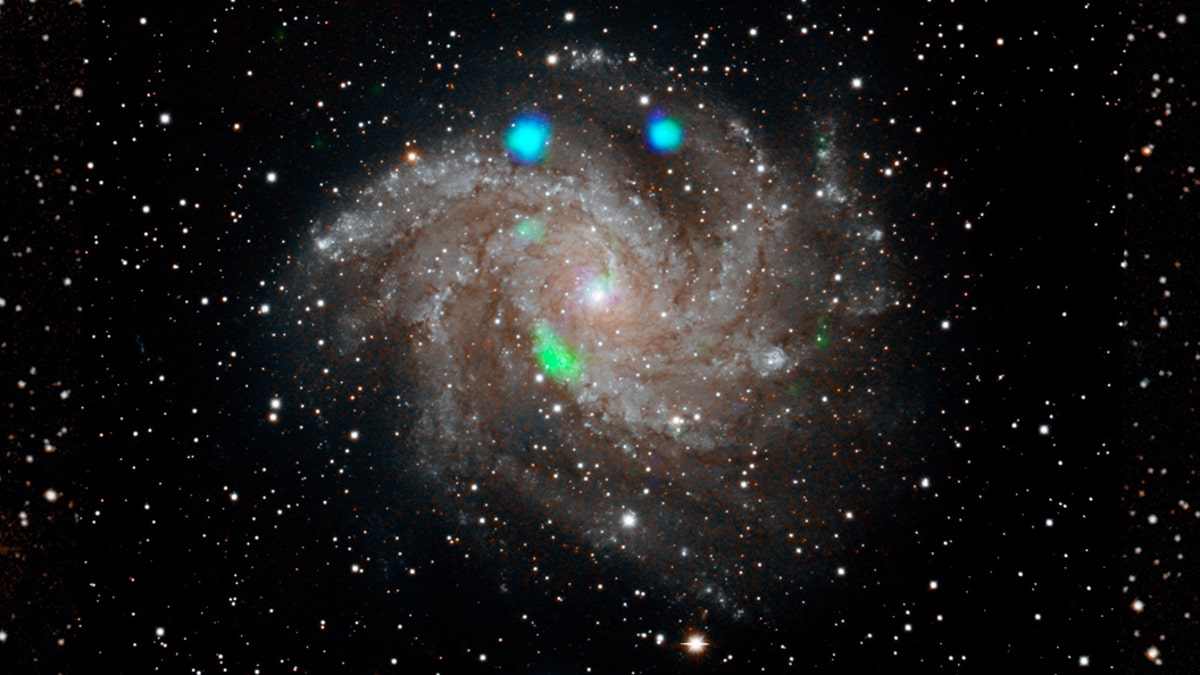Fox News Flash top headlines for Sept. 6
Fox News Flash top headlines for Sept. 6 are here. Check out what's clicking on Foxnews.com
NASA has spotted something mysterious in deep space that it can't quite explain — bright flashes of green and blue spots that appeared and disappeared in a cosmic second.
The NuSTAR X-ray observatory was looking at the Fireworks galaxy (NGC 6946) and saw multiple blobs of blue and green light that appeared and disappeared within weeks, according to a new study published in the Astrophysical Journal. NASA's Chandra X-ray Observatory also witnessed the appearance and disappearance of the green blob, known as an ultraluminous X-ray source (ULX), confirming the sighting.
"Ten days is a really short amount of time for such a bright object to appear," said Hannah Earnshaw, a postdoctoral researcher at Caltech, in a statement. "Usually with NuSTAR, we observe more gradual changes over time, and we don't often observe a source multiple times in quick succession. In this instance, we were fortunate to catch a source changing extremely quickly, which is very exciting."

This visible-light image of the Fireworks galaxy (NGC 6946) comes from the Digital Sky Survey, and is overlaid with data from NASA's NuSTAR observatory (in blue and green). Credit: NASA/JPL-Caltech
FROZEN EARTHLIKE PLANETS COULD SUPPORT LIFE: STUDY
While researchers are quick to point out that ULXs are a common occurrence in space (this was the fourth one spotted in this galaxy), they also note that ULXs are "typically long-lived." With this ULX, there was "visible light ... detected with the X-ray source," which likely rules out that it was a supernova.
So what is it? The researchers offered several theories for the appearance of the green blob, including the fact it could be a black hole consuming another object.
"If an object gets too close to a black hole, gravity can pull that object apart, bringing the debris into a close orbit around the black hole," NASA wrote in the post. "Material at the inner edge of this newly formed disk starts moving so fast that it heats up to millions of degrees and radiates X-rays."
But given the fact that ULX-4 could be a recurring event, another possible explanation is that it is a neutron star. Neutron stars, which are about the same mass as the Sun, are able to draw in material, creating disks of debris that can generate ULX sources.
ASTRONOMERS BAFFLED BY 'COSMIC MOUNTAIN RANGES' JUTTING THROUGH THE MILKY WAY
However, if the neutron star spins too fast, the magnetic fields it creates can actually cause a barrier, which would prevent the material from reaching the star's surface.
"It would kind of be like trying to jump onto a carousel that's spinning at thousands of miles per hour," Earnshaw added.
The barrier effect would prevent the star from being a source of X-rays. However, the barrier might "waver briefly," which would allow material to fall through and land onto the neutron star's surface, which could explain the sudden appearance and disappearance of the ULX, researchers suggested.
"This result is a step towards understanding some of the rarer and more extreme cases in which matter accretes onto black holes or neutron stars," Earnshaw said.

